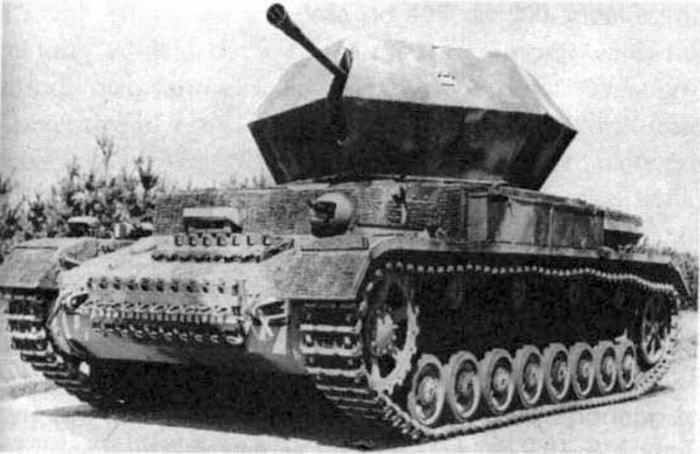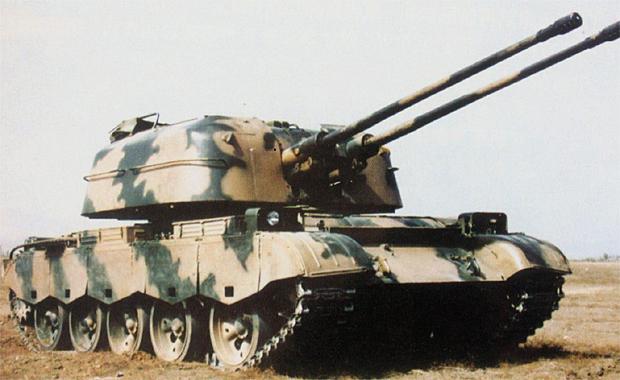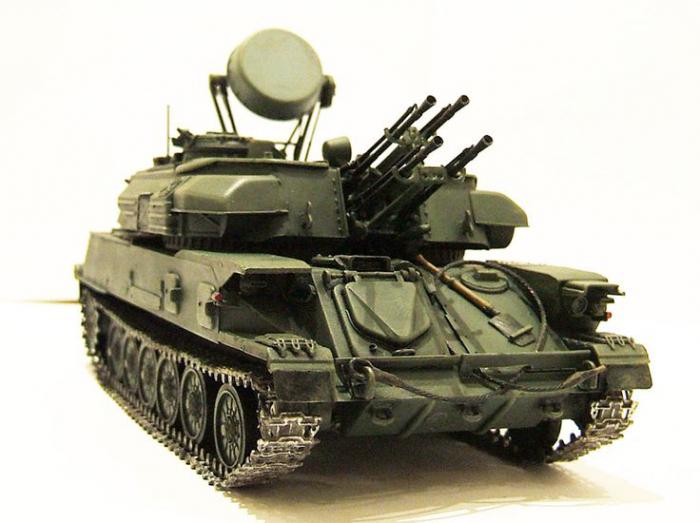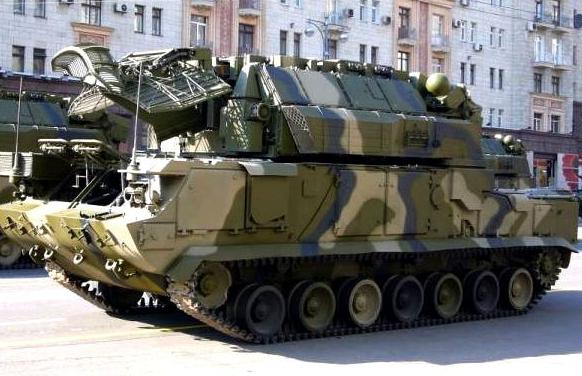Already before the First World War, the task of combating enemy aircraft became one of the most important military-tactical issues. Along with fighter aircraft, ground facilities were also used for this purpose. Conventional guns and machine guns were poorly suited for firing at airplanes, they had an insufficient elevation angle of the barrel. It was possible, of course, to fire from conventional rifles, but the probability of being hit was sharply reduced due to the low rate of fire. In 1906, German engineers proposed mounting a firing point on an armored car, giving it mobility in combination with firepower and the ability to fire at high targets. BA "Erhard" - the world's first self-propelled anti-aircraft gun. Over the past decades, this type of weapons has developed rapidly.
ZSU requirements
The classical organization of an air defense system as understood by military theorists of the interwar period was a single ring structure surrounding particularly important government, industrial, economic or administrative areas. Each element of such an air defense (separate anti-aircraft gun) was subordinate to the command of the fortified area and was responsible for its own airspace sector. This was approximately how the air defense system of Moscow, Leningrad and other large Soviet cities acted in the initial period of the war, when fascist air raids took place almost daily. However, despite its effectiveness, such a course of action was completely inapplicable in conditions of dynamic defense and offensive. Covering each military unit with an anti-aircraft battery is difficult, although it is theoretically possible, but moving a large number of guns is not an easy task. In addition, stationary anti-aircraft artillery mountings, with their unprotected calculations, themselves constitute a target for enemy attack aircraft, which, having determined their deployment, are constantly striving to bomb them and provide themselves with operational space. In order to provide effective cover for forces in the frontline, air defense systems had to have mobility, high firepower and a certain degree of protection. Self-propelled anti-aircraft installation - a machine that has these three qualities.

During the war
During World War II, the Red Army had virtually no anti-aircraft self-propelled guns. Only in 1945 did the first types of weapons of this class (ZSU-37) appear, but in the final battles these guns did not play a big role, the Luftwaffe forces were actually defeated, and besides, fascist Germany suffered a serious lack of fuel. Prior to this, the Soviet army used towed 2K, 25-mm and 37-mm 72-K (Loginov guns). To defeat high-altitude targets, an 85-mm 52-K gun was used. This anti-aircraft installation (like others), if necessary, was also hit by armored vehicles: the high initial velocity of the projectile made it possible to penetrate any defense. But the vulnerability of calculation required a new approach.
The Germans had samples of self-propelled anti-aircraft guns created on the basis of tank chassis ("East Wind" - Ostwind, and "Whirlwind" - Wirbelwind). The Wehrmacht was also armed with the Swedish anti-aircraft mount Nimrod, mounted on a light tank chassis. Initially, it was conceived as an armor-piercing weapon, but against the Soviet “thirty-fours” it was ineffective, but German air defense was successfully used.
ZPU-4
The wonderful Soviet film “The Dawns Here Are Quiet ...”, which reflected the heroism of the girls anti-aircraft gunners who fell into an unforeseen situation (which happened during the war), with all its undoubted artistic merits, contains one inaccuracy, however, excusable and not very important. The ZPU-4 anti-aircraft machine-gun mount, which brave heroines shot down a German plane at the beginning of the picture, only began to be developed at factory No. 2 under the direction of designer I. S. Leshchinsky in 1945. The system weighed a little over two tons, so it was not difficult to tow it. It had a four-wheeled chassis, it cannot be called fully self-propelled due to the lack of an engine, but its high mobility helped to successfully use it in Korea (1950-1953) and in Vietnam. Both military conflicts demonstrated the high efficiency of the model in the fight against helicopters, which were massively used by American troops for landing and assault operations. It was possible to move the ZPU-4 with the help of an army jeep, a gazik, harnessing horses and mules and even just pushing. According to unverified data, this model of technology is used by the opposing forces in modern conflicts (Syria, Iraq, Afghanistan).

Post-war ZSU-57-2
The first decade after the Victory passed under the conditions of undisguised mutual hostility between the Western countries, united in the military alliance of NATO, and the Soviet Union. The tank power of the USSR was second to none in terms of quantity and quality. In the event of a conflict, the convoy of armored vehicles could (theoretically) reach even Portugal, but they were threatened by enemy aircraft. To defend against an air attack on moving Soviet troops was supposed to anti-aircraft installation, adopted into service in 1955. The caliber of the two guns located in the circular tower ZSU-57-2 was considerable - 57 mm. The rotation drive is electro-hydraulic, but for reliability it was duplicated by a manual mechanical system. The sight is automatic, according to the entered data of the target. With a rate of fire of 240 rounds per minute, the unit had an effective range of 12 km (8.8 km vertically). The chassis was fully consistent with the main purpose of the machine, it was borrowed from the T-54 tank, so it could not lag behind the convoy.

"Shilka"
After a long search for suitable and optimal solutions, which took two decades, Soviet designers created a real masterpiece. In 1964, mass production of the latest ZSU-23-4 began, which met all the requirements of modern combat with the participation of enemy attack aircraft. By that time, it had already become clear that low-flying planes and helicopters, which do not fall into the altitude spectrum at which conventional air defense systems are most effective, pose the greatest danger to ground forces. The Shilka anti-aircraft installation had an amazing rate of fire (56 rounds per second), had its own radar and three guidance modes (manual, semi-automatic and automatic). With a caliber of 23 mm, it easily hit high-speed aircraft (up to 450 m / s) at a range of 2-2.5 km. During the armed conflicts of the sixties and seventies (Middle East, South Asian, African), this ZSL showed its best side, mainly due to its fire qualities, but also because of its high mobility, as well as the protection of the crew from the damaging effects of fragments and small-caliber ammunition. Self-propelled anti-aircraft installation "Shilka" has become a significant milestone in the development of domestic mobile systems of the operational regimental level.

"Wasp"
For all the advantages of the Shilka regiment complex, a possible theater of full-scale hostilities could not be provided with a sufficient level of cover when using only artillery systems of a relatively small caliber and short range. To create a powerful “dome” over the division, a completely different one was required - an anti-aircraft missile system. Grad, Tornado, Hurricane and other MLRS, with high fire efficiency, combined into batteries, are an attractive target for enemy aircraft. A mobile system moving over rough terrain, capable of rapid combat deployment, sufficiently protected, all-weather — that was what the troops needed. The Osa anti-aircraft mount, which began to enter military units since 1971, met these requests. The radius of the hemisphere, within the boundaries of which equipment and personnel can feel relatively safe from enemy air raids, is 10 km.
The development of this sample was carried out for a long time, more than a decade (Ellipsoid project). The missile was first assigned to the Tushino Engineering Plant, but for various reasons, the assignment was delegated to the secret OKB-2 (chief designer P. D. Grushin). The main weapon of the memory became four 9M33 missiles. The installation can capture the target on the march, it is equipped with a highly effective noise-free guidance station. It is in service with the Russian Army today.
"Beech"
In the early seventies, the creation of reliable operational-level air defense systems in the USSR was given great importance. In 1972, two enterprises of the defense complex (NIIP and NPO Fazotron) were tasked with creating a system capable of shooting down the Lance ballistic missile, which has a speed of 830 m / s and any other object capable of maneuvering with overloads. The Buk anti-aircraft installation, designed according to this technical task, is a part of the complex, which includes, in addition to it, a detection and target designation station (SOC) and a charging machine. A division that has a unified management system includes up to five launchers. This anti-aircraft gun operates at a range of up to 30 km. On the basis of the 9M38 solid-fuel rocket, which has become unified, sea-based air defense systems have been created. Currently, the complex is in service with some countries of the former USSR (including Russia) and states that previously purchased them.
Tunguska
The development of rocket technology does not detract from the role of artillery weapons, especially in such a crucial area of defense technology as air defense systems. A conventional projectile, in the presence of a good guidance system, may well cause damage no less than a reactive one. An example is a historical fact: during the Vietnam War, specialists from the American company McDonell were forced to hastily develop a cannon container for the F-4 Phantom aircraft, which they initially equipped only with URami, without taking care of the onboard artillery. Soviet designers of ground-based air defense systems approached the issue of combined weapons more prudently. The Tunguska anti-aircraft gun they created in 1982 has hybrid firepower. The main weapon is eight 9M311 missiles. This is the most powerful ZSU at present, its hardware complex provides reliable capture and destruction of targets in a wide range of frequencies and speeds. Particularly dangerous low-flying high-speed aircraft are intercepted by an artillery system, which includes a paired anti-aircraft gun (30 mm) with its own guidance system. The range of defeat by guns is up to 8 km. The appearance of the combat vehicle is no less impressive than its tactical and technical data: the chassis, unified with the "Wasp" GM-352, is crowned with a tower brutally bristling with missiles and trunks.
Abroad
After World War II, the development of highly effective air defense systems began in the USA. Szu "Duster", created on the basis of the Bulldog chassis - a tank with a carburetor engine, was produced in large quantities (in total, more than 3,700 units were produced by Cadillac). The machine was not equipped with a radar, its tower did not have overhead protection, however, it was widely used during the Vietnam War for defense against DRV air raids.
A more advanced guidance system received the French mobile air defense system AMX-13 DCA. It was equipped with an airborne radar, operating only after combat deployment. The completion date for the design work is 1969, but AMX was produced up to the 80s, both for the needs of the French army and for export (mainly to Arab countries adhering to a pro-Western political orientation). This anti-aircraft mount proved to be generally good, but in almost all respects it was inferior to the Soviet Shilka.
Another American model of this class of weapons is the MZ-163 Volcano, built on the basis of the widespread M-113 armored personnel carrier. The machine began to enter military units in the early 1960s, so Vietnam was the first (but not the last) test for it. The firepower of the M-163 is very high: six Gatling machine guns with revolving barrels gave out a rate of fire of almost 1,200 rounds per minute. Protection is also impressive - it reaches 38 mm of armor. All this provided the sample with export potential; it was supplied to Tunisia, South Korea, Ecuador, North Yemen, Israel and some other countries.
How is the SZU different from the air defense system
In addition to artillery and hybrid air defense systems, the most common missile defense systems are currently the most widely used, such as the mentioned Buk. As the name of the class of weapons itself implies, these systems work, as a rule, not as autonomous ground support vehicles, but as part of divisions that include combat units for various purposes (loading, command and staff, mobile radars and guidance stations). In the classical sense, any memory (anti-aircraft mount) should provide protection from enemy aircraft of a certain operational area on its own, without the need to concentrate additional aids, therefore the Patriot, Strela, S-200 - S-500 series in this article not considered. These air defense systems, which form the basis of the air security of many countries, including Russia, deserve a separate review. They, as a rule, combine the ability to intercept targets in wide high-speed and high-altitude ranges, have great efficiency, but - due to their high cost - are inaccessible to many countries that are forced to rely on conventional mobile installations in their defense, inexpensive and reliable.